Targeting Hypoxia and Autophagy Inhibition via Delivering Sonodynamic Nanoparticles With HIF-2α Inhibitor for Enhancing Immunotherapy in Renal Cell Carcinoma
- PMID: 39396375
- PMCID: PMC11670269
- DOI: 10.1002/adhm.202402973
Targeting Hypoxia and Autophagy Inhibition via Delivering Sonodynamic Nanoparticles With HIF-2α Inhibitor for Enhancing Immunotherapy in Renal Cell Carcinoma
Abstract
Immune checkpoint blockers (ICBs) therapy stands as the first-line treatment option for advanced renal cell carcinoma (RCC). However, its effectiveness is hindered by the immunosuppressive tumor microenvironment (TME). Sonodynamic therapy (SDT) generates tumor cell fragments that can prime the host's antitumor immunity. Nevertheless, the hypoxic microenvironment and upregulated autophagy following SDT often lead to cancer cell resistance. In response to these challenges, a hypoxia-responsive polymer (Poly(4,4'-azobisbenzenemethanol-PMDA)-mPEG5k, P-APm) encapsulating both a HIF-2α inhibitor (belzutifan) and the ultrasonic sensitize (Chlorin e6, Ce6) is designed, to create the nanoparticle APm/Ce6/HIF. APm/Ce6/HIF combined with ultrasound (US) significantly suppresses tumor growth and activates antitumor immunity in vivo. Moreover, this treatment effectively transforms the immunosuppressive microenvironment from "immune-cold" to "immune-hot", thereby enhancing the response to ICBs therapy. The findings indicate that APm/Ce6/HIF offers a synergistic approach combining targeted therapy with immunotherapy, providing new possibilities for treating RCC.
Keywords: HIF‐2α; immunotherapy; renal cell carcinoma; sonodynamic therapy.
© 2024 The Author(s). Advanced Healthcare Materials published by Wiley‐VCH GmbH.
Conflict of interest statement
The authors declare no conflict of interest.
Figures

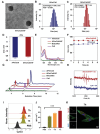
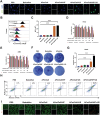


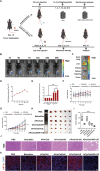
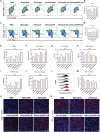
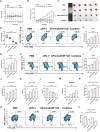
Similar articles
-
Nanosonosensitizer-Augmented Sonodynamic Therapy Combined with Checkpoint Blockade for Cancer Immunotherapy.Int J Nanomedicine. 2021 Mar 5;16:1889-1899. doi: 10.2147/IJN.S290796. eCollection 2021. Int J Nanomedicine. 2021. PMID: 33707944 Free PMC article.
-
Polymer-based nanodrugs enhance sonodynamic therapy through epigenetic reprogramming of the immunosuppressive tumor microenvironment.J Control Release. 2025 Apr 10;380:125-137. doi: 10.1016/j.jconrel.2025.01.086. Epub 2025 Feb 5. J Control Release. 2025. PMID: 39892649
-
Necroptosis-inducing nanobubbles for effective oxygen delivery and enhanced sonodynamic immunotherapy of breast cancer via UTND.Eur J Pharm Biopharm. 2025 May;210:114675. doi: 10.1016/j.ejpb.2025.114675. Epub 2025 Feb 22. Eur J Pharm Biopharm. 2025. PMID: 39993510
-
Allosteric inhibition of HIF-2α as a novel therapy for clear cell renal cell carcinoma.Drug Discov Today. 2019 Dec;24(12):2332-2340. doi: 10.1016/j.drudis.2019.09.008. Epub 2019 Sep 18. Drug Discov Today. 2019. PMID: 31541711 Review.
-
Targeting HIF-2 Alpha in Renal Cell Carcinoma.Curr Treat Options Oncol. 2023 Sep;24(9):1183-1198. doi: 10.1007/s11864-023-01106-y. Epub 2023 Jul 5. Curr Treat Options Oncol. 2023. PMID: 37403008 Review.
Cited by
-
Strategic Advances in Targeted Delivery Carriers for Therapeutic Cancer Vaccines.Int J Mol Sci. 2025 Jul 17;26(14):6879. doi: 10.3390/ijms26146879. Int J Mol Sci. 2025. PMID: 40725126 Free PMC article. Review.
-
The pathogenesis and therapeutic implications of metabolic reprogramming in renal cell carcinoma.Cell Death Discov. 2025 Apr 19;11(1):186. doi: 10.1038/s41420-025-02479-9. Cell Death Discov. 2025. PMID: 40253354 Free PMC article. Review.
References
-
- Siegel R. L., Miller K. D., Wagle N. S., Jemal A., CA Cancer J. Clin. 2023, 73, 17. - PubMed
-
- Bukavina L., Bensalah K., Bray F., Carlo M., Challacombe B., Karam J A., Kassouf W., Mitchell T., Montironi R., O'Brien T., Panebianco V., Scelo G., Shuch B., van Poppel H., Blosser C D., Psutka S P., Eur. Urol. 2022, 82, 529. - PubMed
-
- a) Yan X. Q., Ye M. J., Zou Q., Chen P., He Z. S., Wu B., He D. L., He C. H., Xue X. Y., Ji Z. G., Chen H., Zhang S., Liu Y. P., Zhang X. D., Fu C., Xu D. F., Qiu M. X., Lv J. J., Huang J., Ren X. B., Cheng Y., Qin W. J., Zhang X., Zhou F. J., Ma L. L., Guo J. M., Ding D. G., Wei S. Z., He Y., Guo H. Q., et al., Ann. Oncol. 2024, 35, 190; - PubMed
- b) Peng Y. L., Xiong L. B., Zhou Z. H., Ning K., Li Z., Wu Z. S., Deng M. H., Wei W. S., Wang N., Zou X. P., He Z. S., Huang J. W., Luo J. H., Liu J. Y., Jia N., Cao Y., Han H., Guo S. J., Dong P., Yu C. P., Zhou F. J., Zhang Z. L., J. Immunother. Cancer 2022, 10, e004206. - PMC - PubMed
-
- a) Atkins M. B., Jegede O. A., Haas N. B., McDermott D. F., Bilen M. A., Stein M., Sosman J. A., Alter R., Plimack E. R., Ornstein M., Hurwitz M., Peace D. J., Signoretti S., Denize T., Cimadamore A., Wu C. J., Braun D., Einstein D., Catalano P. J., Hammers H., J. Clin. Oncol. 2022, 40, 2913; - PMC - PubMed
- b) Pal S. K., McGregor B., Suárez C., Tsao C. K., Kelly W., Vaishampayan U., Pagliaro L., Maughan B. L., Loriot Y., Castellano D., Srinivas S., McKay R. R., Dreicer R., Hutson T., Dubey S., Werneke S., Panneerselvam A., Curran D., Scheffold C., Choueiri T. K., Agarwal N., J. Clin. Oncol. 2021, 39, 3725; - PMC - PubMed
- c) McDermott D. F., Lee J. L., Bjarnason G. A., Larkin J. M. G., Gafanov R. A., Kochenderfer M. D., Jensen N. V., Donskov F., Malik J., Poprach A., Tykodi S. S., Alonso‐Gordoa T., Cho D. C., Geertsen P. F., Climent Duran M. A., DiSimone C., Silverman R. K., Perini R. F., Schloss C., Atkins M B., J. Clin. Oncol. 2021, 39, 1020. - PMC - PubMed
MeSH terms
Substances
Grants and funding
LinkOut - more resources
Full Text Sources
Medical

